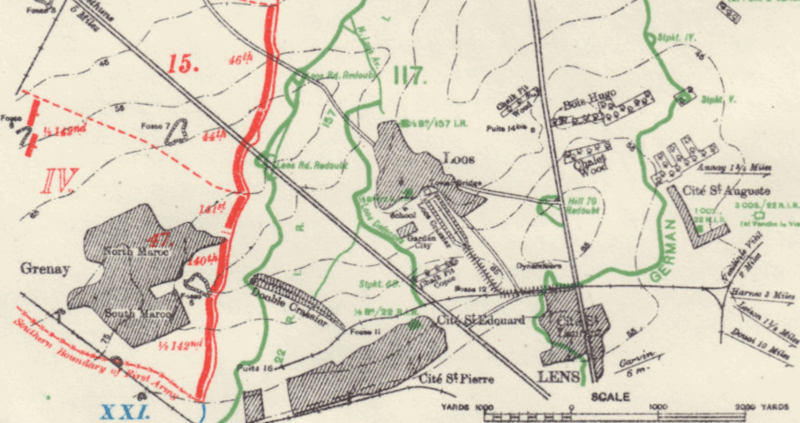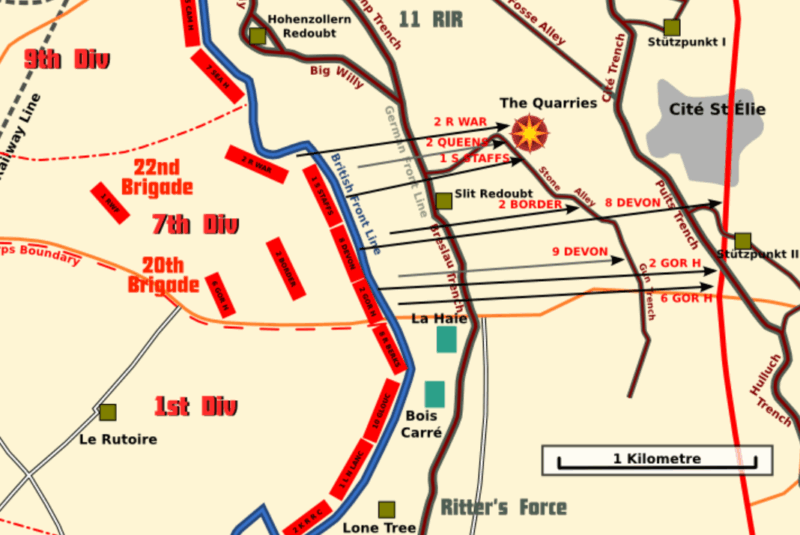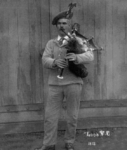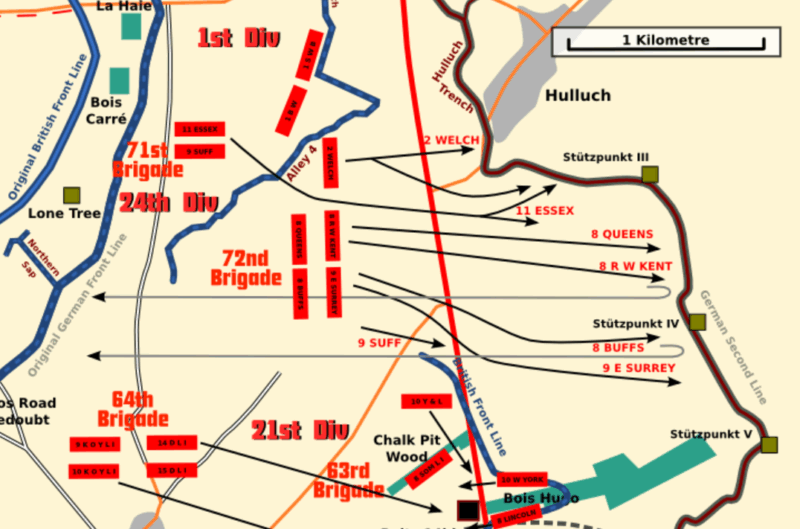The Battle of Loos took place over two weeks, from 25th September to 8th October, as part of the Third Battle of Artois, a joint Franco-British offensive.
Loos was the largest British offensive in 1915 (‘The Big Push’) and saw the first British use of poison gas. It was also the first major deployment of volunteers recruited under Kitchener’s ‘New Army’ scheme.


Langholm’s eight fatalities were all on the first day. They were from five different regiments:
- 7th Division
- 20th Brigade
- 2nd Border Regiment
- 20th Brigade
- 15th (Scottish) Division
- 44th Brigade (Highland regiments)
- 9th Black Watch
- 10th Gordon Highlanders
- 46th Brigade
- 7th KOSB
- 44th Brigade (Highland regiments)
- 24th Division
- 72nd Brigade
- 8th Royal West Surrey (‘8th Queens’)
- 72nd Brigade
7th Division
The 7th Division, including 2nd Border Regiment, managed to penetrate the German barbed wire and take a number of trenches. This was partly due to Private Arthur Vickers of 2nd Royal Warwickshire cutting the wire while standing up in full view of the enemy, for which he was awarded the Victoria Cross.

| Date | Surname | Forenames | Event | Unit | No. | Rank | Age | Address | Comments |
|---|---|---|---|---|---|---|---|---|---|
| 25th Sep | Thomson | Frank | Killed in action | 2nd Border Regiment | 4970 | Private | 22 | Caroline Street |
Frank Thomson was an apprentice tanner with Charles Paisley. He enlisted in the New Year of 1914 and was a bomb thrower.
15th Division
The 44th Brigade, including 9th Black Watch and 10th Gordon Highlanders, managed to advance into Loos. There they took out German resistance through the day, partly with the help of a 17-year old local girl called Emilienne Moreau, who pointed out key German locations and took part in the offensive herself, eliminating a couple of enemy threats with grenades and a pistol.
The 48th Brigade, like others, was badly affected by Britain’s own chlorine gas, which drifted back over its own lines. Nevertheless, 7th KOSB, spurred on by their piper Daniel Laidlaw (see below), destroyed the Loos Road machine gun nests with grenades and proceeded into the village.

Despite the gas, 7th KOSB piper Daniel Laidlaw climbed up onto the parapet and walked up and down the trench, playing his bagpipes. This had a remarkable effect, prompting a charge forwards. He was badly injured in both legs but continued to play, and was later awarded the Victoria Cross.

| Date | Surname | Forenames | Event | Unit | No. | Rank | Age | Address | Comments |
|---|---|---|---|---|---|---|---|---|---|
| 25th Sep | Borthwick | Joseph | Killed in action | 10th Gordon Highlanders | S/4669 | Private | 19 | Henry Street | |
| 25th Sep | Comrie | John | Killed in action | 9th Black Watch | S/4506 | Private | 32 | Eskdale Place | |
| 25th Sep | Elliot | William | Killed in action | 7th KOSB | 13833 | Private | 33 | Eskdaill Street | |
| 25th Sep | Malcolm | John | Killed in action | 7th KOSB | 20 | ||||
| 25th Sep | Scott | Isaac | Killed in action | 7th KOSB | 15696 | Private | 26 | Knox’s Buildings | |
| 25th Sep | Scott | James | Killed in action | 7th KOSB | Temp 2nd Lieut | 19 | Kilncleuch | ||
| 25th Sep | Thomson | David | Killed in action | 7th KOSB | 15705 | Acting Corporal | 24 | Drove Road |
Joe Borthwick was a warehouseman at Ford Mill, the son of James, a tanner.
John Comrie was also a Ford Mill employee, a power loom tuner. He and his wife Jane have had eight children, three of whom died in infancy, and another is due imminently. Their youngest is called Bertha Roeber Comrie, probably after a German-born nurse who worked until a few months ago at the Thomas Hope Hospital, sometimes attending births outside the hospital. Perhaps she helped to prevent another Comrie infant death. She left the UK after 35 years of residency because of anti-German hostility towards her.
William Elliot was a wool sorter at Buccleuch Mill, the son of John, also a wool sorter. He had a wife Elizabeth and a son, and was a good cricketer.
John Malcolm was carrying a tank of explosive material that was hit by shrapnel. He was an apprentice joiner with James Telford in Parliament Square and played for Langholm Rugby Club. His elder brother James, who was employed by William Milroy, ironmonger, was wounded through the right hand.
Isaac Scott was the youngest of Sarah Scott’s five soldier sons (see 12th May in the Diary). He worked at Waverley Mill.
James Scott, known as ‘Mac’, was the son of Captain James and Marian Scott, late of Kilncleuch (currently empty). James senior recently became political secretary to Samuel Samuels, MP for Wandsworth. His eldest son John died of wounds in November last year.
David Thomson was a hairdresser’s apprentice with James Barr in Langholm, then a worker in the Singer sewing machine factory in Clydebank, Glasgow.

24th Division
8th Royal West Surrey (‘8th Queens’) supported 8th Royal West Kent in an attack from 11 am on the area between Stützpunkt III and IV. By 1 pm they had almost reached the German barbed wire but were severely depleted by machine gun fire and artillery and retreated from 1.30 pm.

| Date | Surname | Forenames | Event | Unit | No. | Rank | Age | Address | Comments |
|---|---|---|---|---|---|---|---|---|---|
| 25th Sep | MacKnight | James | Killed in action | 8th Royal West Surrey | G/2676 | 37 | Eskdaill Street | Son of Jane MacKnight and late James MacKnight, Langholm |
James MacKnight was formerly an apprentice to Robert Scott, printer, and a member of Chalmers Church.